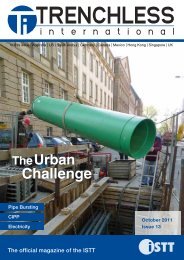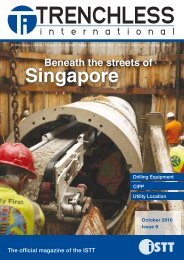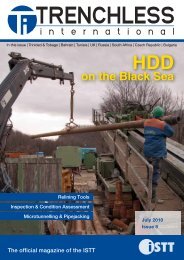Boring - Trenchless International
Boring - Trenchless International
Boring - Trenchless International
Create successful ePaper yourself
Turn your PDF publications into a flip-book with our unique Google optimized e-Paper software.
Pumping station back in action<br />
Per Aarsleff’s recently formed Pipe Technologies division has successfully<br />
completed its first pipeline repair on a damaged pumping station discharge<br />
pipeline at Bawdsey, on the East Suffolk coast in the United Kingdom. The<br />
deformed and leaking cast iron pipeline was restored with CIPP.<br />
projects<br />
April 2010 - <strong>Trenchless</strong> <strong>International</strong><br />
The liner was turned inside out, pushed onto the outlet nozzle of the<br />
inversion drum and held in place with special clamping bands.<br />
Bawdsey land drainage<br />
pumping station and its 450 mm diameter<br />
discharge pipeline were built in<br />
the late 1950s to serve an agricultural<br />
catchment of nearly 13 square kilometres,<br />
half of which lies at or below mean<br />
sea level. The Bawdsey Pumping Station<br />
automatically controls water levels<br />
and discharges surface water drainage<br />
through the pipeline, under a flood<br />
defence embankment and into the tidal<br />
estuary of the River Deben. The overall<br />
pipe is about 30 metres long. However,<br />
a 22 metre long section, from the pumping<br />
station to the outfall, has deformed<br />
under the weight of the embankment<br />
and sunk about 250 mm into a shallow<br />
‘U’ shape. When the pump operates at<br />
its flow of 0.45 metres cubed per second<br />
and pressure head of five metres, water<br />
is forced out of the damaged pipe’s<br />
open joints, jeopardising the integrity of<br />
the flood defences.<br />
A swallow hole appeared in the<br />
embankment, forcing the Environment<br />
Agency, which is responsible for the<br />
embankment, and the East Suffolk<br />
Internal Drainage Board (ESIDB), responsible<br />
for Bawdsey Pumping Station, to act<br />
quickly. The ESIDB is one of a consortium<br />
of five boards making up the Water<br />
Management Alliance (WMA), which<br />
together protect about 1,220 square kilometres<br />
of East Anglia. There was an<br />
acute risk of an embankment breach<br />
and the WMA looked at alternative repair<br />
options.<br />
“We had to act quickly and considered<br />
various alternatives, including replacing<br />
the entire section of pipe, but that would<br />
have required major invasive surgery<br />
to the embankment,” says WMA district<br />
engineer Ian Hart.<br />
“Instead we opted for a less invasive<br />
option of relining the pipe without<br />
the need for any excavation, in the<br />
The liner was pushed through the<br />
manhole and into the pipeline ready<br />
for inversion.<br />
spirit of modern, keyhole surgery.<br />
I contacted Aarsleff and they confirmed<br />
the feasibility of repairing the pipeline<br />
in-situ with a tailor made liner. We then<br />
appointed a local civil engineering contractor,<br />
Breheny, to oversee the repair<br />
as they had rebuilt the pumping station<br />
in 2003–04. Aarsleff purpose-made the<br />
liner to suit and installed it in a very slick<br />
and professional operation.”<br />
Breheny provided clear unobstructed<br />
access to the pump house, removed<br />
the pipeline inspection cover within the<br />
pumping station and opened the outfall<br />
flap valve to allow Aarsleff to make a<br />
start on the lining during low tide. A thin<br />
plastic pre-liner, with a blanked end,<br />
was first inserted into the damaged<br />
pipeline using compressed air to protect<br />
the main resin-impregnated polyester<br />
liner during installation. The main liner<br />
was designed and made by Aarsleff’s<br />
in-house designers to withstand the<br />
positive and negative pressures and<br />
the high flow rates generated when the<br />
pump operates. It was made inside out<br />
from resin impregnated thin layers of<br />
special needle felt so that the outside<br />
surface eventually became the inner<br />
smooth bore surface when the liner was<br />
inverted into the damaged pipeline. The<br />
main liner was packed in flake ice during<br />
delivery from the factory to the site to<br />
prevent premature curing.<br />
At the pump house the liner was<br />
wound into the special inversion drum,<br />
which was positioned close to the pump<br />
house entrance. A length of liner, twice<br />
the distance from the drum to the pipeline<br />
manhole, was pulled out of the<br />
drum. This protruding section was then<br />
turned back on itself so the inside of<br />
the liner was now on the outside. It was<br />
pushed onto the outlet nozzle of the<br />
inversion drum and held in place with<br />
special clamping bands. The liner was<br />
then lowered down into the manhole<br />
and guided by hand a short distance<br />
into the pre-liner and into the entrance<br />
of the damaged 22 metre long pipeline.<br />
The inversion drum was then pressurised<br />
with compressed air, which forced<br />
the liner, with its closed end, to rapidly<br />
unwind from the drum and unfold and<br />
invert itself through and out of the open<br />
end of the damaged pipeline. The inversion<br />
process only took a few seconds<br />
with the air pressure forcing the liner<br />
through the prelined damaged pipe and<br />
against the wall, which effectively acted<br />
as a former for the new lining.<br />
A steam pressure hose was then<br />
connected from a special boiler to the<br />
inversion drum to heat up the liner. At<br />
the same time a steam exhaust pipe<br />
was also inserted into the exposed section<br />
of liner protruding from the outfall.<br />
Temperature probes were attached to the<br />
liner, which was gradually heated by the<br />
steam to 110°C and held for four hours to<br />
cure the resin-impregnated, 13 mm thick<br />
The special inversion drum with liner was<br />
positioned close to the pump house entrance.<br />
The inversion drum was pressurised with compressed air, which forced the liner to<br />
unfold and invert itself through and out of the open end of the damaged pipeline.<br />
liner. By using steam curing, the required<br />
high temperature could be maintained,<br />
even though the end of the liner was<br />
submerged during high tide. The entire<br />
liner inversion and curing process was<br />
controlled and monitored by a computer<br />
on board a self-contained lorry fitted with<br />
highly advanced, purpose-built installation<br />
equipment, including the boiler and<br />
compressors, needed to perform the<br />
No-Dig, CIPP process.<br />
After curing and cooling, the ends<br />
of the new liner, which formed a<br />
self-supporting pipe within a pipe, were<br />
cut off at the next low tide. Aarsleff’s<br />
lining crew completed their work in just<br />
one and half days and Breheny followed<br />
on, restoring the outfall flap valve and<br />
returning the pump house to full working<br />
order. The repair to the Bawdsey<br />
pipeline was completed without any<br />
excavation or disturbance of the pipeline<br />
and was done in a fraction of the<br />
time and at a fraction of the cost it would<br />
have taken using conventional, open-cut<br />
pipe replacement methods.<br />
projects<br />
April 2010 - <strong>Trenchless</strong> <strong>International</strong><br />
44<br />
45
















